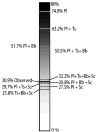A modest model explains the distribution and abundance of Borrelia burgdorferi strains
- PMID: 16606995
- PMCID: PMC1851668
A modest model explains the distribution and abundance of Borrelia burgdorferi strains
Abstract
The distribution and abundance of Borrelia burgdorferi, including human Lyme disease strains, is a function of its interactions with vertebrate species. We present a mathematical model describing important ecologic interactions affecting the distribution and abundance of B. burgdorferi strains, marked by the allele at the outer surface protein C locus, in Ixodes scapularis ticks, the principal vector. The frequency of each strain in ticks can be explained by the vertebrate species composition, the density of each vertebrate species, the number of ticks that feed on individuals of each species, and the rate at which those ticks acquire different strains. The model results are consistent with empirical data collected in a major Lyme disease focus in New England. An applicable extension of these results would be to predict the proportion of ticks carrying human infectious strains of B. burgdorferi from disease host densities and thus predict the local risk of contracting Lyme disease.
Figures




References
-
- Soule M, Estes J, Miller B, Honnold D. Strongly interacting species: conservation policy, management, and ethics. Bioscience. 2005;55:170–176.
-
- Benach JL, Bosler EM, Hanrahan JP, Coleman JL, Habicht GS, Bast TF, Cameron DJ, Ziegler JL, Barbour AG, Burgdorfer W, Edelman R, Kaslow RA. Spirochetes isolated from the blood of two patients with Lyme disease. N Engl J Med. 1983;308:740–742. - PubMed
-
- Burgdorfer W, Barbour AG, Hayes SF, Benach JL, Grunwaldt E, Davis JP. Lyme-Disease—a tick-borne spirochetosis. Science. 1982;216:1317–1319. - PubMed
-
- Centers for Disease Control and Prevention. Lyme disease—United States, 2001–2002. MMWR Morb Mortal Wkly Rep. 2004;53:365–369. - PubMed
-
- O’Connell S, Granstrom M, Gray JS, Stanek G. Epidemiology of European Lyme borreliosis. Zentralbl Bakteriol. 1998;287:229–240. - PubMed
Publication types
MeSH terms
Grants and funding
LinkOut - more resources
Full Text Sources
Medical
